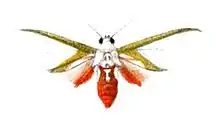| Eupseudosoma | |
|---|---|
 | |
| Eupseudosoma larissa | |
| Scientific classification | |
| Domain: | Eukaryota |
| Kingdom: | Animalia |
| Phylum: | Arthropoda |
| Class: | Insecta |
| Order: | Lepidoptera |
| Superfamily: | Noctuoidea |
| Family: | Erebidae |
| Subfamily: | Arctiinae |
| Subtribe: | Phaegopterina |
| Genus: | Eupseudosoma Grote, 1865 |
| Type species | |
| Charidea nivea Herrich-Schäffer, [1855] | |
Eupseudosoma is a genus of moths in the family Erebidae. The genus was erected by Augustus Radcliffe Grote in 1865.[1] The best known and most widespread species is Eupseudosoma involutum, the snowy eupseudosoma, a bright white moth which is found from the southern United States right down to the south of South America. There are a few other species found across the Americas.
Species
- Eupseudosoma aberrans Schaus, 1905
- Recorded food plants include Diospyros, Eucalyptus, Eugenia and Psidium
- Eupseudosoma agramma Hampson, 1901
- Eupseudosoma grandis Rothschild, 1909
- Eupseudosoma involutum Sepp, 1855 – snowy eupseudosoma
- Recorded food plants include Diospyros, Eucalyptus, Eugenia and Psidium
- Eupseudosoma larissa (Druce, 1890)
Former species
- Eupseudosoma bifasciata (Cramer, [1779])
- Eupseudosoma eurygania (Druce, 1897)
References
- ↑ Savela, Markku. "Eupseudosoma Grote, [1866]". Lepidoptera and Some Other Life Forms. Retrieved September 12, 2019.
This article is issued from Wikipedia. The text is licensed under Creative Commons - Attribution - Sharealike. Additional terms may apply for the media files.